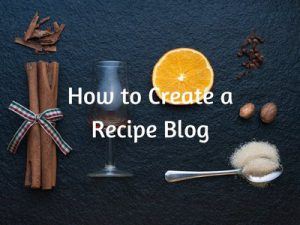 I love helping women (and men too) start their own online businesses and one of the questions that is being asked frequently is how to create a recipe blog. Now, I might not be a very good cook, but having run my own blog for more than two years, I do know a thing or two about online marketing.
I love helping women (and men too) start their own online businesses and one of the questions that is being asked frequently is how to create a recipe blog. Now, I might not be a very good cook, but having run my own blog for more than two years, I do know a thing or two about online marketing.
In this article, I dived a little deeper into the food niche to help you discover various ways to monetize from your culinary passion.
Basic Setup
You have probably heard of platforms such as Google Blogger or Tumblr that offer free blogging services. Yes, they are quite popular, but I wouldn’t recommend them for the long term. If you are serious about making money online, I suggest that you have your own custom domain (not a subdomain like blogspot.com) and you’ll need a private hosting service for better security and control of your marketing outreach.
Domains are extremely affordable these days. For example, at the SiteRubix hosting platform, a .com only cost you $13.99/year for the domain, privacy protection as well as a business email. What’s more, the company also provides quick installation and powerful hosting for WordPress, which is what I would recommend to build a recipe blog.
Two Ways to Monetize
There are generally two ways to generate money online (this can be applied to other niches as well). Affiliate marketing is the most popular option because it’s easy to set up. No inventory and minimal capital investment (domain, hosting +/- training fee). All you need to do is to promote other brand’s products and earn from sales commissions. Becoming an Amazon Associate is one such way to get involved in lucrative affiliate programs.
Another income source would be to produce and market your own product, whether it is digital (eBook, online courses, etc.) or physical (own merchandise, cookbook, etc.). Obviously, the latter would require more resource planning and patience as readers need time to be familiar with your online personality and cooking style before they actually want to buy your products.
Five Ways to Drive Traffic
From this point onward, I’ll discuss about acquiring traffic because essentially, without it, there’s absolutely no way you can generate any online revenue.
1) Blogging
The grandfather of all traffic sources is actually the blog itself and by that, I mean textual content. The how-to’s, product reviews, recipe sharing – these are all information that people are ‘hungry’ for. The best way to reach out to this group of audience is to imagine the type of words they would use to search on Google.
These words would then be used as targeted keywords to create your blog posts. Better yet, when you target low competition keywords, your blog will have higher chances of getting onto page 1 of the search results where the majority of free traffic derives.
Meanwhile, somewhere in your content, you can insert relevant affiliate links and send people to check out your recommended products on, for example, the Amazon online marketplace. This is the most classic way of monetization and it works great when you have a lot of helpful information to offer.
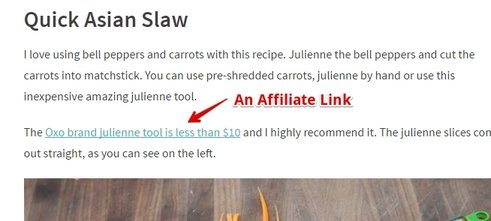
2) Social Sharing
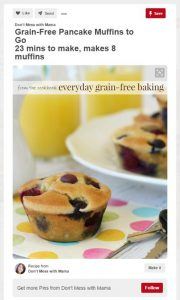 This is a no brainer. Whenever people see something interesting, they instinctively share them online these days and social networks are great at propagating this.
This is a no brainer. Whenever people see something interesting, they instinctively share them online these days and social networks are great at propagating this.
Recipe blogs are naturally visual oriented so what social media does is that it pulls an image from your blog onto the social shares to attract readers to click on the image link which will then direct them to your blog.
For example, Pinterest is an all time favorite platform for anything visual and artistic. This blogger has cleverly embed her website address in the muffin image so that whenever people want to read more, they would have to visit or follow her blog for details. This is one form of social traffic that works the same for Facebook, Google Plus and Tumblr too.
3) Recipe Card
I am really excited to share with you this one. As we all know, food recipes are the highlight of your blog, but if you merge them with other text, it can be very dull to read. That’s where recipe cards come into play. These are actually plugins that you can install (that’s why I recommend using WordPress) and they can perform some really cool stuff with just a few simple settings.
- Allow your recipe (and your blog address) to be printed and shared.
- Allow people to share on food networks such as Yummly.
- Markup your blog so that your site gets a Recipe View and a strategic spot on Google search results. Just to show you, these are all recipe sites that have incorporated the markup feature. Noticed that each of them comes with a nice image on the left, reviews/ratings as well as a short description on what the recipe is all about.
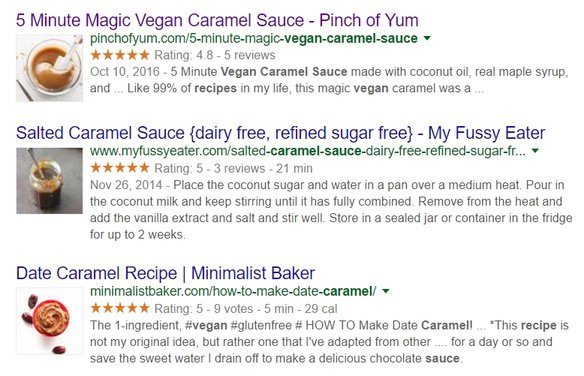
And you thought you need to hire a professional for this? No you don’t!
4) Affiliate Store
I have been doing some research on this and it turns out that you can actually build an online store even as an affiliate marketer. There are unique plugins out there that can create a store using your recommended products and still have your readers check out at the merchant’s site.
The catch is that it makes your blog more professional and display products in a way that is personal and pleasant for your readers. Although an affiliate store does not rank superbly well as a content, it’s a great place within your blog to summarize what you have to offer through your product reviews. When you make things convenient for shopping, people will convert into customers.
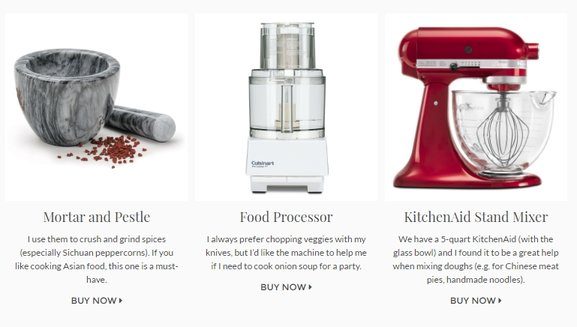
5) YouTube Videos
I am pretty sure you are familiar with YouTube. Reading can be dull sometimes, but what better way to engage with your audience than to create a cooking video, right? There are two advantages to this
- A blog with an embedded video builds more engagement with the audience; people stay longer on your site to watch.
- When you post on YouTube, you’ll drive traffic back to your blog as well or even straight to your affiliate links (which is totally allowed as long as you are not being intrusive)
The next time you watch a cooking tutorial video, scroll all the way down to the part that says ‘Show More’. See all the links that the blogger has included here? That’s where conversions are taking place.
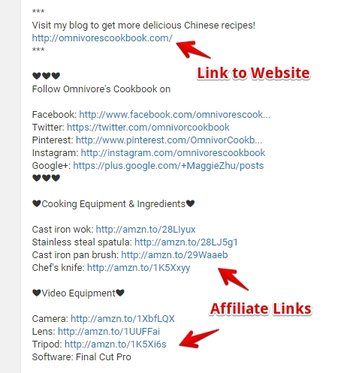
6) Sell Your Own Product
So maybe you are more talented than I thought. If you are a professional cook, an author in the making or a food expert, then you should seriously consider selling your own products on top of doing affiliate marketing. You could create your own recipe book, promote cooking classes or sell merchandise. Anything that you like.
By now, you would have a large group of followers and this is the best time to promote yourself as a brand. It’s easy. If you don’t want to split revenue marketing on other platforms like Kindle, sign up for a PayPal account, upload your products online and add a PayPal buy button on your blog.
The Recipe For Online Success
So there you go; one domain with multiple monetization techniques. You don’t have to execute all at one go. Start with your core content – your blog – and branch out from there. The more you publish, the more people would share your stuff and the more traffic you’ll bring to your site.
Hopefully I have helped answer your question on how to create a recipe blog. I look forward to see you get started. For more tools and training resources, please visit my recommended online program for details.
Have any thoughts or questions about this topic? Share with us in the comment below.
You may also be interested to read;
How to Build Your First Food Blog

Hi Cathy,
Great monetization strategies there. Now unless I have misunderstood you recommend that using an amazon store alongside quality content as ideal. I read the linked page. Appreciated if you can confirm that using a store builder is very safe if you use it as a subdomain like store.mysite.com as the subdomain is treated as an entirely new site as it has its own WordPress and so on.
My thinking is that this could serve as a great addition to reviews and increase the number of clicks to the vendor (Amazon) and thus increase potential sales.
Hi Derek, I would recommend combining a store and blogging – all on the same WordPress platform. I think too many redirects to different interface can harm the user experience. The WooCommerce plugin has a feature that can enable you to list and link products to Amazon via your affiliate links. It’s great to use if you have a collection of items to promote within your niche.
Hi Cathy,
I like your ideas for making a recipe blog into a source of income. There’s no limit to the number recipes and cooking ideas one can write about. Hundreds of recipe posts can cumulatively attract a lot of traffic. That would translate to making a lot sales through your links.
Great ideas for those who are into this niche.
I’m not much of a cook either but I do know that the food niche is huge online. I always think of chefs and people who are really into cooking should have a blog. So many vegan blogs coming out these days too. This is definitely a good opportunity for someone who is into recipes and great information for them to get started and take action!
I have not written a food blog (yet) but I am very intrigued by the recipe card feature. One thing I struggle with in my blog is social media. Literally the only people who like my posts are family. I want to be able to attract visitors on Pinterest. Your suggestions are pretty universal as it ultimately boils down to targeting low competition key words. Right now I am focusing on those under 100, as close to 0 as possible.
Hi, I struggle with social media too at the beginning and to be honest, they are quite overwhelming. Eventually, I settle with just two networks – Google Plus and Pinterest – because their presentation and interaction appeals to me. If you want to grow your Pinterest audience, I suggest to take some courses on how to do it right. But before that, you’ll need some good amount of blog content so that there’s at least something to share.
Using low competition keywords is great, but remember to also get long tail phrases with purchasing intent as they are much closer to the sales conversion funnel for your product reviews – assuming that you have one.
I have been asked by many of my female friends whether they can create a cooking blog and earn from it, I say yes but it always get difficult for me to explain “how” from there after, so I am going to refer your site to them for sure. ( By the way I too want to make a recipe site, just realized after reading this)
Amazon is indeed a great affiliate platform, but I tend to like your “create your own product” idea more because it is always a pleasure to sell your own stuff than others, but for gaining experience, I guess beginners should prefer promoting others products first.
I think blogging is awesome, but people are more attracted towards video blogs now a days. I know many who have succeeded uploading their recipes online. So all you people reading this, start working on this idea now! I believe your blog is a perfect guide for anyone looking to make their passion a way to make money.